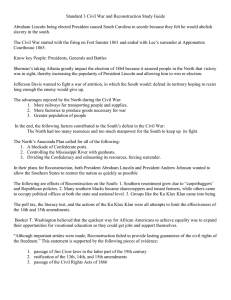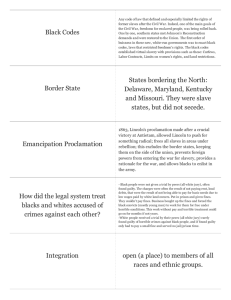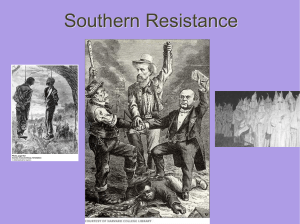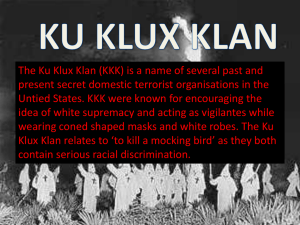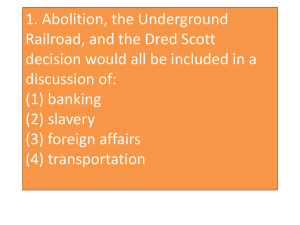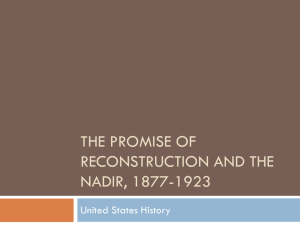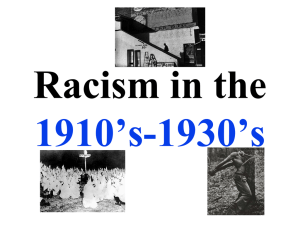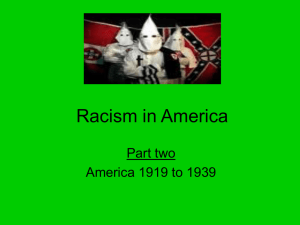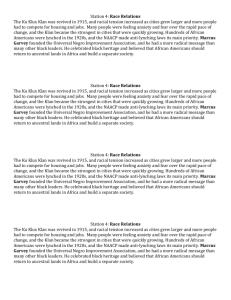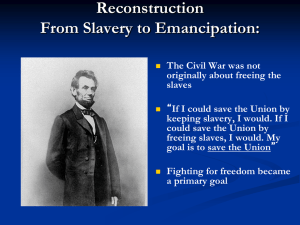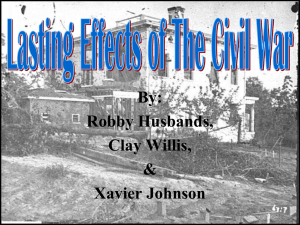Race, Racism, and African American History from the Civil War to WWII
advertisement
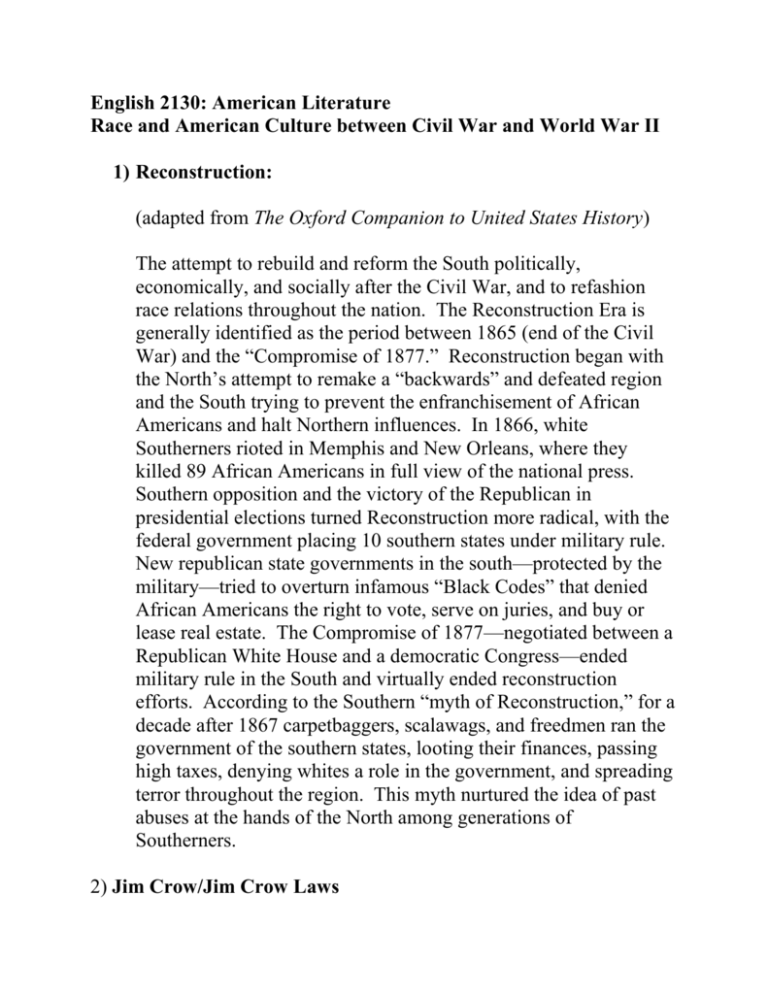
English 2130: American Literature Race and American Culture between Civil War and World War II 1) Reconstruction: (adapted from The Oxford Companion to United States History) The attempt to rebuild and reform the South politically, economically, and socially after the Civil War, and to refashion race relations throughout the nation. The Reconstruction Era is generally identified as the period between 1865 (end of the Civil War) and the “Compromise of 1877.” Reconstruction began with the North’s attempt to remake a “backwards” and defeated region and the South trying to prevent the enfranchisement of African Americans and halt Northern influences. In 1866, white Southerners rioted in Memphis and New Orleans, where they killed 89 African Americans in full view of the national press. Southern opposition and the victory of the Republican in presidential elections turned Reconstruction more radical, with the federal government placing 10 southern states under military rule. New republican state governments in the south—protected by the military—tried to overturn infamous “Black Codes” that denied African Americans the right to vote, serve on juries, and buy or lease real estate. The Compromise of 1877—negotiated between a Republican White House and a democratic Congress—ended military rule in the South and virtually ended reconstruction efforts. According to the Southern “myth of Reconstruction,” for a decade after 1867 carpetbaggers, scalawags, and freedmen ran the government of the southern states, looting their finances, passing high taxes, denying whites a role in the government, and spreading terror throughout the region. This myth nurtured the idea of past abuses at the hands of the North among generations of Southerners. 2) Jim Crow/Jim Crow Laws (adapted from Encyclopedia of the Harlem Renaissance) First introduced by the white minstrel performer T. D. Rice in the late 1820, by the 1830s “Jim Crow” became a popular term describing African Americans as slow-witted, clownish, and contented slaves. By the late nineteenth century, “Jim Crow” had become synonymous with the entire culture of formal and legal separation of the races. In order to roll back civil rights given to freed slaves during Reconstruction (Reconstruction Act of 1867 and Civil Rights Act of 1875), white supremacists in the North and South instituted a set of legal acts—known as “Jim Crow Laws”—that affirmed and naturalized the subordinate position of African Americans. Throughout the 1870s several statutes enacted across the South prohibited intermarriage between the races, and the repeal of the Civil Rights Act by the Supreme Court in 1883 allowed businesses to discriminate on the basis of race. By the mid-1880s, segregated educational facilities became mandated by law in most southern states; poll taxes and literacy tests disenfranchised virtually all African American men. “Jim Crow Laws” were epitomized by the Supreme Court’s 1896 decision on Plessy v. Ferguson, affirming the constitutionality of racial segregation in public facilities and institutions, with the dubious proviso that the separate facilities for blacks were also “equal” to those reserved for whites (hence: “separate but equal”). Outside of the legal system, violence against African Americans—such as the lynching of supposed sex offenders or intimidation at polling stations—further cemented the power of “Jim Crow” as a cultural and social system. 3) Invisible Empire/Ku Klux Klan (Dictionary of American History, ed. Stanley Kutler) A Reconstruction-era terrorist group founded in Pulaski, Tennessee, in 1866, the KKK has been resurrected in a variety of forms from that time to the present. The Reconstruction-era Klan used violence or the threat of violence to thwart perceived challenges to white supremacy and Democratic rule. Its mayhem was intended as a means of controlling black labor, reinforcing social deference to whites, disciplining perceived instances of interracial sexual relationships, and punishing any whites sympathetic to or working on behalf of the Republican party. Targeting African American leaders such as ministers, teachers, and politicians, the Klan used murders, floggings, beatings, or sexual assaults to demoralize the wider black community. Though fading in importance after the end of Reconstruction, the Klan was idealized in Thomas Dixon’s book The Clansman and the 1915 motion picture Birth of a Nation as a savior of white civilization and helped reviving a “second” Klan during the 1920s. The second Klan developed a highly effective and hierarchical organization, with local, state, and national leaders, public relations, marketing operations, and mass recruitment efforts. It had widespread membership in the South, Midwest, and West, gaining control of state politics in states such as Alabama, Oklahoma, and Indiana. The second Klan professed to uphold a general sense of white, protestant hegemony, with perceived threats coming from Catholics, Jews, African Americans, and a sense of decline in religion, “pure womanhood,” and the family. The rise of the Civil Rights movement in the 1950s again spurred Klan violence, now originating in a number of regional, independent organizations, committing hundreds of murders and acts of intimiation against civil rights activists. The Klan lost influence with increased media coverage and a rise in sympathy for the sacrifice of civil rights workers. 4) The Jazz Age a. Historical Background i. The Twenties 1. images of bathtup gin, speakeasies, and decadence, 2. superficial image masks a more complex history 3. America grappling with disruptions of ethnic and cultural conflict, growth of mass media, and a consumer culture, as well as a transformation of women’s roles 4. A decade of prosperity 5. big business enjoyed unprecedented approval 6. “The man who builds a factory builds a temple, the man who works there, worships there.” President Calvin Coolidge ((1923-1929) 7. booming stock market 8. especially booming automobile industry 9. more and more Americans work for corporations 10. more leisure time, but also more alienating labor 11. consumer goods revolution 12. much money spent by average Americans on consumer goods and entertainment 13. increasingly sophisticated advertisement industry 14. changing role of women: 15. the persona of the flapper a. bobbed hair, cosmetics, short skirts, smoking, drinking, jazz dancing and sexual experimentation 16. 19th amendment: right of women to vote 17. greater number of women joining the work force 18. but: women still faced much discrimination in the work place 19. another change: now the majority of Americans lived in urban, rather than rural areas 20. cultural conflict: supposed permissiveness of the age found a backlash from religious fundamentalists and conservatives 21. e.g.: The Scopes Trial: prohibiting the teaching of evolution in public schools 22. 18th amendment: 1920: prohibition of alcohol 23. also: large-scale anti-immigration sentiments, as well as racism, and lynching in the South 24. high cultural activity a. besides F., Hemingway, William Carlos Williams, Gertrude Stein, and the writers of the Harlem Renaissance i. Zora Neale Hurston ii. Langston Hughes, and Claude McKay 5) The Great Migration a. Great Migration occurred primarily between the two world wars. However, between 1910 and 1970, approximately six and a half million African Americans migrated out of the South. While in 1910, 80 percent of blacks lived in the South, less than half lived there by 1970, with only 25 percent in the rural South. b. Chicago, New York, and Philadelphia, as well as other Northern cities, were the initial destinations of most migrants. The West later became a major destination. c. Life in the South was difficult for African Americans for a variety of reasons, including problems associated with sharecropping and the accompanying natural disasters of the late 1910s and '20s; Jim Crow legislation, which resulted in segregated public facilities, transportation, and schools; and violence, symbolized by the Ku Klux Klan and most graphically displayed in public lynchings. d. The North was viewed as the promised land, an idea perpetuated by the need for factory workers and the fact that pay in such factories was typically as much as three times more than what blacks made working the land in the South. e. While segregation was not legalized in the North, as it was in the South, blacks experienced prejudice and racism in the North, commonly known as "de facto segregation." f. Life in the North presented its own challenges for blacks, including poor living conditions and harsh, often dangerous work environments.
